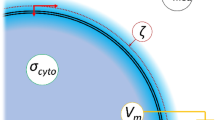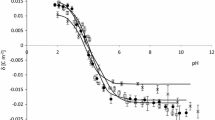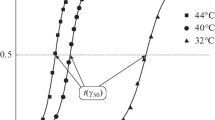Summary
The external electric field strength required for electrical hemolysis of human red blood cells depends sensitively on the composition of the external medium. In isotonic NaCl und KCl solutions the onset of electrical hemolysis is observed at 4 kV per cm and 50% hemolysis at 6 kV per cm, whereas increasing concentrations of phosphate, sulphate, sucrose, inulin and EDTA shift the onset and the 50% hemolysis-value to higher field strengths. The most pronounced effect is observed for inulin and EDTA. In the presence of these substances the threshold value of the electric field strength is shifted to 14 kV per cm. This is in contrast to the dielectric breakdown voltage of human red blood cells which is unaltered by these substances and was measured to be ∼1 V corresponding in the electrolytical discharge chamber to an external electric field strength of 2 to 3 kV per cm. On the other hand, dielectric breakdown of bovine red blood cell membranes occurs in NaCl solution at 4 to 5 kV per cm and is coupled directly with hemoglobin release. The electrical hemolysis of cells of this species is unaffected by the above substances with exception of inulin. Inulin suppressed the electrical hemolysis up to 15 kV per cm. The data can be explained by the assumption that the reflection coefficients of the membranes of these two species to bivalent anions and uncharged molecules are field-dependent to a different extent. This explanation implies that electrical hemolysis is a secondary process of osmotic nature induced by the reversible permeability change of the membrane (dielectric breakdown) in response to an electric field. This view is supported by the observation that the mean volumes of ghost cells obtained by electrical hemolysis can be changed by changing the external phosphate concentration during hemolysis and resealing, or by subjecting the cells to a transient osmotic stress immediately after the electrical hemolysis step. An interesting finding is that the breakdown voltage, although constant throughout each normally distributed ghost size distribution, increases with increasing mean volume of the ghost populations.
Similar content being viewed by others
References
Bernhardt, J., Pauly, H. 1973. On the generation of potential differences across membranes of ellipsoidal cells in an alternating field.Biophysik 10:89
Bjerrum, J., Schwarzenbach, G., Sillén, L.G. 1957. Stability Constants. The Chemical Society, London
Bodemann, H., Passow, H. 1972. Factors controlling the resealing of the membrane of human erythrocyte ghosts after hypotonic hemolysis.J. Membrane Biol. 8:1
Burger, S.P., Fujii, T., Hanahan, D.J. 1968. Stability of the bovine erythrocyte membrane. Release of enzymes and lipid components.Biochemistry 7:3682
Coster, H.G.L., Zimmermann, U. 1975. Direct demonstration of dielectric breakdown of the membranes ofValonia utricularis: The role of energy dissipation.Biochim. Biophys. Acta 382:410
Coster, H.G.L., Zimmermann, U. 1975. The mechanism of electrical breakdown in the membranes ofValonia utricularis.J. Membrane Biol. 22:73
Coster, H.G.L., Zimmermann, U. 1975. Direct demonstration of dielectric breakdown of the membranes ofValonia utricularis.Z. Naturforsch. 30c:77
Kedem, O., Katchalsky, A. 1958. Thermodynamic analysis of the permeability of biological membranes to nonelectrolytes.Biochim. Biophys. Acta 27:229
Lowenstein, L.M. 1960. The effect of albumin on osmotic hemolysis.Exp. Cell Res. 20:56
Neumann, E., Rosenheck, K. 1972. Permeability changes induced by electric impulses in vesicular membranes.J. Membrane Biol. 10:279
Pilwat, G., Zimmermann, U., Riemann, F. 1975. Dielectric breakdown measurements of human and bovine erythrocyte membranes using benzyl alcohol as a probe molecule.Biochim. Biophys. Acta 406:424
Riemann, F., Zimmermann, U., Pilwat, G. 1975. Release and uptake of haemoglobin and ions in red blood cells induced by dielectric breakdown.Biochim. Biophys. Acta 394:449
Rosenheck, K., Lindner, P., Pecht, I. 1975. Effect of electric fields on light-scattering and fluorescence of chromaffin granules.J. Membrane Biol. 20:1
Sillén, L.G., Martell, A.E. 1964. Stability Constants. The Chemical Society, London
Stein, W.D. 1967. The movement of molecules across cell membranes. Academic Press, New York
Tosteson, D.C. 1964. Regulation of cell volume by sodium and potassium transport.In: The Cellular Function of Membrane Transport. J.F. Hoffman, editor. Prentice-Hall, Englewood Cliffs, New Jersey
Wilbrandt, W. 1941. Osmotische Natur sogenannter nicht-osmotischer Hämolysen. (Kolloidosmotische Hämolyse) I. Mitteilung.Pflueger's Arch. Gesamte Physiol. Menschen. Tiere.245:22
Zimmermann, U. 1973. Deutsches Patentamt Auslegeschrift 2326161 vom 23.5.1973
Zimmermann, U. 1973. Transportprozesse durch Biomembranen. Jahresbericht 1973 der Kernforschungsanlage Jülich GmbH, p. 55. Nuclear Research Center, Jülich
Zimmermann, U., Pilwat, G., Beckers, F., Riemann, F. 1976. Effects of external electrical fields on cell membranes.Bioelectrochem. Bioen. 3:58
Zimmermann, U., Pilwat, G., Riemann, F. 1974. Dielectric breakdown of cell membranes.Biophys. J. 14:881
Zimmermann, U., Pilwat, G., Riemann, F. 1974. Dielectric breakdown of cell membranes.In: Membrane Transport in Plants. U. Zimmermann and J. Dainty, editors. p. 146. Springer-Verlag, Heidelberg
Zimmermann, U., Pilwat, G., Riemann, F. 1974. Deutsches Patentamt, Auslegeschrift 2405119 vom 2.2.1974
Zimmermann, U., Pilwat, G., Riemann, F. 1974. Reversibler dielektrischer Durchbruch von Zellmembranen in elektrostatischen Feldern.Z. Naturforsch. 29c:304
Zimmermann, U., Pilwat, G., Riemann, F. 1975. Preparation of erythrocyte ghosts by dielectric breakdown of the cell membrane.Biochim. Biophys. Acta 375:209
Zimmermann, U., Riemann, F., Pilwat, G. 1976. Enzyme loading of electrically homogeneous human red cell ghosts prepared by dielectric breakdown.Biochim. Biophys. Acta 436:460
Zimmermann, U., Schulz, J., Pilwat, G. 1973. Transcellular ion flow inEschericha coli B and electrical sizing of bacteria.Biophys. J. 13:1005
Author information
Authors and Affiliations
Rights and permissions
About this article
Cite this article
Zimmermann, U., Pilwat, G., Holzapfel, C. et al. Electrical hemolysis of human and bovine red blood cells. J. Membrain Biol. 30, 135–152 (1976). https://doi.org/10.1007/BF01869664
Received:
Revised:
Issue Date:
DOI: https://doi.org/10.1007/BF01869664




